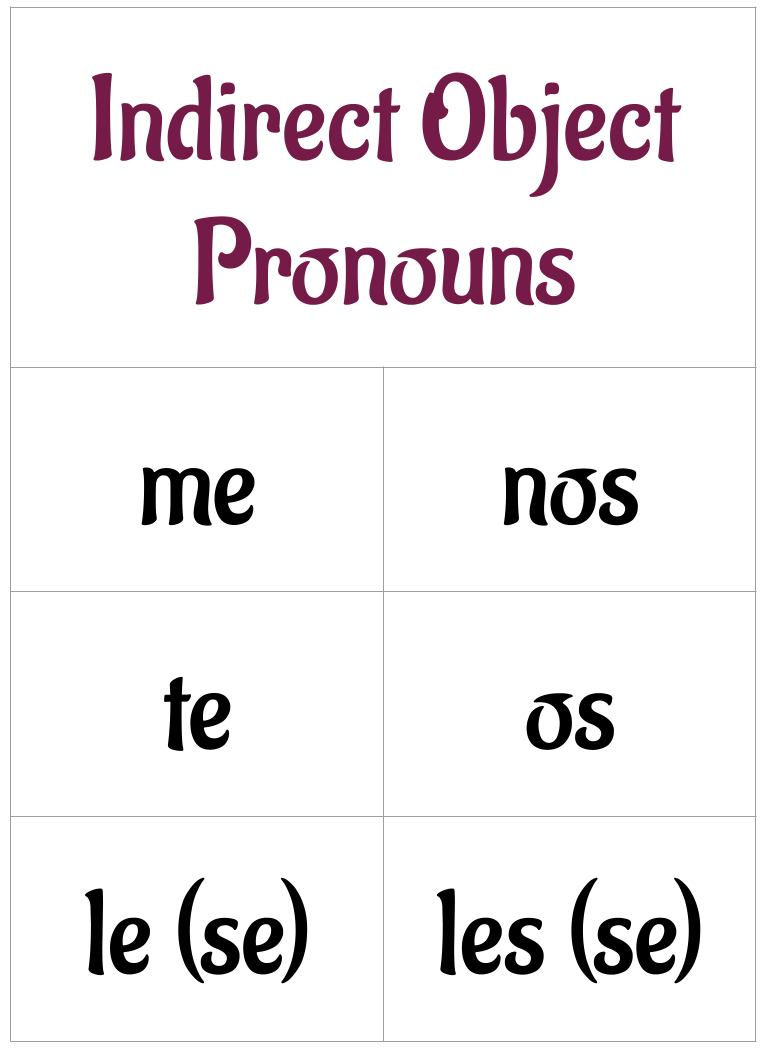Indirect Objects & Direct Objects
What are "Indirect Objects"?
An indirect object does receive the action of the verb, but indirectly, unlike the direct object that receives full action of the verb. In English, we identify the indirect object by asking "to whom" or "for whom" an action is performed. In the case of the Direct Object it can be either a person or a thing. However, in the case of the Indirect Object is almost always a person or living thing.
Here is an example of an Indirect Object.
Here is an example of an Indirect Object.
|
Mi amigo Juan está asando el pollo para nosotros esta tarde.
My friend Juan is grilling the chicken for us this afternoon. |
In the example above, "Nosotros" or "We" are the indirect object because it answers the question "For whom or to whom is the chicken being grilled?". In English the indirect object pronouns are similar to the Direct Object pronouns, with the exception of "it". A similar pattern is found with the indirect object pronouns for Spanish
Pronouns to Replace the Indirect Object
Again, the pronouns are used to make communication more efficient when all involved already know what we are talking about, and don't need to be repetitive. Here are the Indirect Object Pronouns for Spanish.
Indirect Object Pronoun Placement
The same rules that apply to the Direct Object Pronouns, also apply to the Indirect Object pronouns.
Option 1: |
One Verb, One Choice.
|
|
Ella nos dio las llaves en la casa.
She gave us the keys in the house. Justin les dio los cepillos de dientes después de su cita. Justin gave them the tooth brushes after their appointment. |
Option 2: |
Two Verbs, Two Choices:
|
*An important note to recognize is the difference between using the Direct or Indirect Object Pronouns, is that when using the Direct Object Pronoun you have to replace the actual object, you cannot leave it in the sentence. However, with Indirect Objects CAN be left in the sentence WITH the corresponding pronoun to add emphasis as TO WHOM or FOR WHOM the action was done.
|
El mesero no nos dio la comida a nosotros. La dio a la otra mesa.
The waiter did not give the food to us. He gave it to the other table. |
Direct Objects & Indirect Object Pronouns together
In Spanish you can the Direct and Indirect Object Pronouns can be placed in the same sentence. In this case, we should now understand that the Direct Object is replaced by its corresponding pronoun, and the Indirect Object can still be present in the sentence with its corresponding pronoun.
|
Mateo tiene los platos en el comedor.
Mateo los tiene en el comedor. Nacho da la comida a los niños del orfanato. Nacho les da la comida a los niños del orfanato. (Nacho les da la comida.) |
When you have both a direct object pronoun and an indirect object pronoun in the same sentence, the indirect object pronoun comes first.
|
Me lo darán mañana en la clase.
They will give it to me tomorrow in class. Ellos te la venden. They sell them to you. |
Whenever both pronouns begin with the letter “l” change the first pronoun to “se.”
The reason for changing “le lo” to “se lo” is merely to avoid the tongue-twisting effect of two short consecutive words that begin with the letter “l”. To demonstrate this, first quickly say “les las” and then quickly say “se las.” See how much easier it is to say “se las?”
The reason for changing “le lo” to “se lo” is merely to avoid the tongue-twisting effect of two short consecutive words that begin with the letter “l”. To demonstrate this, first quickly say “les las” and then quickly say “se las.” See how much easier it is to say “se las?”
|
Se la van a dar esta noche.
They are going to give it to her tonight. Se los compras. You buy them for him. |
When you have two verbs, the same rules apply.
ONE VERB = ONE CHOICE
Pronouns go BEFORE the conjugated verb.
TWO VERBS = TWO CHOICES
1) BEFORE the conjugated verb or
2) CONNECTED to the END of the infinitive/gerund.
ONE VERB = ONE CHOICE
Pronouns go BEFORE the conjugated verb.
TWO VERBS = TWO CHOICES
1) BEFORE the conjugated verb or
2) CONNECTED to the END of the infinitive/gerund.
|
Ellos te los van a cocinar.
Ellos van a cocinártelos. They are going to cook them for you. Yo se los tengo que dar en la mañana. Yo tengo que dárselos en la mañana. |
*Important Note: Because you are adding two extra syllables, you add an accent mark on the stressed vowel in the second verb to indicate that it is still stressed.

